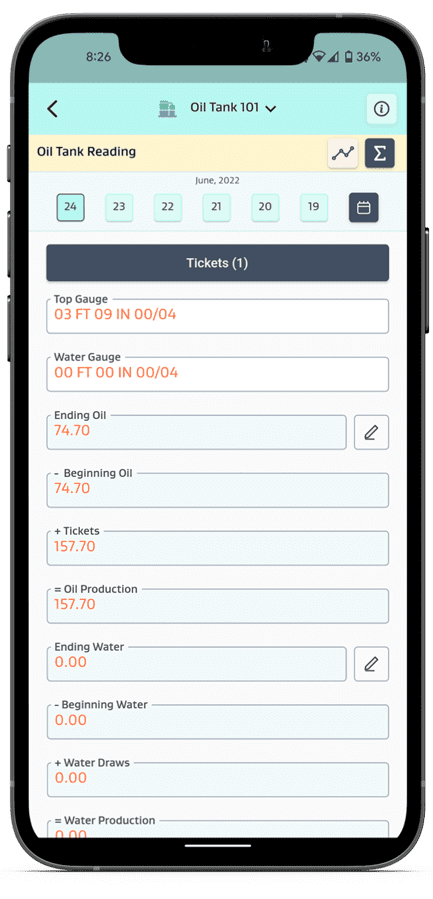Lease operators, pumpers, gaugers – these field staff go by many names depending on what part of the country they work in. When it comes to powering the digital oil field, field staff are where the road meets the rubber, touching so many vital workflows that impact an energy company’s performance. Field operations are where allocated volumes become revenue, wells are tuned to optimal production, and troubleshooting of equipment is prioritized on a daily basis to minimize downtime.
Field staff also play an important role in HSE, regulatory compliance and ESG. No matter what business process they support, field staff share a common need to hop in a truck for daily well routes, capture a variety of data types, and share that information with stakeholders in the back office. Despite digital oil field advances that have brought a step change in efficiency to drilling and completions, production operations have largely adhered to traditional methods of field data capture. At best, field staff might collect and distribute operational data in a spreadsheet and, at worst, hand record field data on a grease sheet. In either case, the timeline from capturing the information, validating it, and delivering it to the right people can take weeks, time that creates uncertainty around critical business performance drivers, including production targets versus actuals, revenue, expense accrual and regulatory compliance.
Reducing Field Data Capture Friction
In a modern, connected, and data driven world, the energy industry needs a paradigm shift in field operations data management that connects the field to the back office to drive dozens of mission critical workflows, from lease assessments and allocations to production optimization, facilities maintenance, health-safety-environment (HSE) and asset retirement. Solving the problem must start with empowering field staff with better technology to digitally gather field data inside tools that allow them to work smarter not harder. Indeed, user acceptance and the friction that cumbersome field data capture technologies create are two reasons why the field has been slow in adopting mobile and cloud-based solutions.
In order to efficiently feedback office workflows, like production accounting with up-to-date, calibrated, and validated allocations, the energy back office needs more than robust field data gathering that arms field staff with a user-friendly mobile app. Data silos persist across the digital oil field with a scattered landscape of disconnected field operations data, allocation networks, SCADA systems, hydrocarbon accounting and ERP. Driving oil and gas business performance and advancing operational efficiencies requires not just connecting the field to the back office accounting systems, but connecting production volumes and revenue to division orders and lease administration for faster, more reliable interest owner payments that require fewer prior period adjustments.
To optimize and accelerate production accounting or any of the other workflows field staff support, operators need to upgrade their field data gathering technology as well as deploy solutions that can fully integrate with their back office systems through application programming interfaces (API).
W Energy Software, a pioneer in cloud native SaaS solutions, designed a unified, energy-focused ERP platform that encompasses core upstream oil and gas business functions, including well life cycle management, land, financials and production operations. Its JOYN Production and Field Services solution provides field staff a fully integrated Field Data Gathering solution that ensures the best use of their time while transmitting vital information back to an organization’s back office.

Giving Field Staff Back More of Their Day
Legacy field operations solutions force field staff to haul cumbersome information technology along their daily routes, such as laptops and company-issued devices that require data to be collated in a spreadsheet and manually uploaded in a Wi-Fi hotspot at designated locations. With JOYN, field staff bring their own device (BYOD) by easily installing the mobile app on personal smartphones and tablets, providing field data gathering capabilities even in the most remote regions of the Permian Basin. JOYN technology also ensures field operations’ data accuracy through robust validation of every data point, significantly reducing data entry errors or “fat fingering” of incorrect data.
Importantly, the app stores field data in a local database on the mobile device, which allows field staff to continue working in an offline mode with JOYN providing uninterrupted step-by-step details on active workflows, and enabling data to be captured and validated without a connection to the cloud. Connectivity to W Energy Software’s cloud-based field operations platform is seamlessly managed by the app as field operations data is held and released when a cell tower is in range. Lease assessments, run tickets, water hauls and other field events are instantly synchronized for cloud-based reporting, dashboards and analytics.
Available for Android and iOS devices, the JOYN mobile OneApp eliminates the “last mile” digital delay associated with traditional field data capture. It provides intuitive data entry for field staff as well as real-time trend intelligence on equipment and daily routes.
JOYN reduces a typical workday for a lease operator, pumper, gauger or field tech by up to 25 percent by eliminating data wrangling and manual data entry and completely digitizing critical daily field operations workflows, such as trip planning and data entry. What used to be an eight-hour route becomes a six-hour job, freeing up valuable time for field staff.
JOYN optimizes field staff scheduling, saving time and creating measurable business benefits for field staff and organizations with less friction compared to legacy field data capture. A typical well site with 50 lease operators can save over 29,000 operator hours per year equipped with JOYN’s next generation field data gathering and mobile app. W Energy Software customers who leverage JOYN field data gathering, including supermajors and leading producers in U.S. basins, reallocate these hours to capture more operationally critical data and to other high-value activities. This includes preventative maintenance data like compressor maintenance and plunger inspections.
Oil Field Management by Exception
Unlike legacy field data capture solutions, JOYN also empowers oil and gas teams to manage their assets by exception by automatically scheduling and prioritizing field staff. It delivers a daily site visit plan to any phone, tablet or mobile device based on operational priorities. The Daily Site Plan maps out the field visit route with site names, alerts and alert types.
Equipment readings that fall outside of acceptable levels automatically trigger alerts that bring the right field staff into the decision loop when needed, such as down wells and high tank levels. Additional alerts can be easily configured based on SCADA data or other inputs.
As a result, JOYN ensures that high-priority sites will receive the attention they deserve. With operational priorities updated and delivered directly to field staff mobile devices, JOYN eliminates the risk of oversights or missed signals.

The Power of Cloud Integrations
Through APIs and a battled-tested systems integration process, JOYN can be integrated with any back office information system – commercial and proprietary data sources – in less than one month. For example, JOYN can pull master data and allocation networks directly into the cloud-based field operations platform as well as push data to systems via API or to back office users over the web, accelerating the flow of field operations data across an organization.
Calculations are performed in the cloud, enabling even the most complex allocations to be run in minutes versus hours with an on-premise server, providing greater scalability, reliability and data visibility for all stakeholders. These allocated volumes can then be made readily available to operations teams, enabling enhanced “pump by exception” outcomes that are delivered back to the lease operator on their mobile device.
At a glance, users can visualize production volumes for any product and the disposition on the allocation network at every node. With a continuous and validated stream of field data, JOYN creates new opportunities for governance and data consumption. The technology provides self-service access to reliable production data with granular security control over what each user can see. Production analysts can easily edit networks and create new ones as necessary, while users with limited needs can be given restricted, read only access.
One Solution to a Set of Problems
With its JOYN field operations platform, W Energy Software has introduced one solution to a set of problems that empowers today’s workforce with the modern technology needed to navigate daily field data gathering complexity, support multiple business workflows, and seamlessly integrate reliable field data with the energy back office. Flexibility sets JOYN apart from legacy field data capture or narrow field operations apps. JOYN’s configurable data entry, validation, reporting, integration and workflow engine empower customers to adapt the technology to any oil and gas business process.
For instance, the actual layout of a site is configurable, allowing field staff to walk through a battery and configure JOYN to match the order of the assets at the site. Such flexibility provides field staff with more efficient routes while giving organizations greater control to enforce standards and procedural compliance.
JOYN’s field data gathering, and workflow engine are also relied on by supermajors and leading oil and gas companies to support EPA greenhouse gas (GHG) reporting and reduce ESG liability by guiding field workers through standardized procedures for remediating fugitive gas emissions. The configurable technology bolsters an operator’s environmental and compliance reporting such as auditory-visual-olfactory (AVO) reports, tank inspections, MIA report, SPCC, WV well inspections reports and many more scenarios.
On the front lines of field data gathering that supports vital oil and gas business processes, field staff will continue to power the digital oil field into the future. Field staff are crucial to organizational performance, from hitting production targets and meeting ESG goals. By empowering them with technology and fostering a data-driven culture, oil and gas teams will reap tangible results, uplift margins, and accelerate business performance by bridging the field and the back office.
Hari Dutt is the director of project management at Seven Lakes Technologies (a W Energy Software company). He has more than 16 years of experience spent across multiple functions, including engineering, operations management, enterprise sales, financial analysis, account management and product management. Within the JOYN ecosystem, Dutt focuses on driving value for customers, primarily working on the technology’s strategic product roadmap, ensuring that it is appropriately prioritized, and executing overall product strategy.
Oil and gas operations are commonly found in remote locations far from company headquarters. Now, it's possible to monitor pump operations, collate and analyze seismic data, and track employees around the world from almost anywhere. Whether employees are in the office or in the field, the internet and related applications enable a greater multidirectional flow of information – and control – than ever before.




